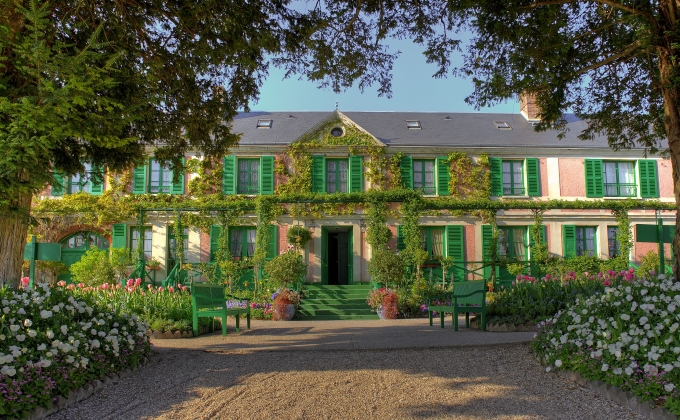Golf in France - Normandy
Above: Maison de Claude Monet
The administrative district of Normandy, to the northwest of Île-de-France along the Atlantic coast, is another escape for city dwellers. Forty-five miles outside the city, the flower garden and arboretum that Claude Monet created in Giverny have been painstakingly replanted and restored –you’ll recognize many views of his careful-ly-planned garden from his paintings, and the colorful décor inside his house is also remarkable.
Proceeding northwest, the countryside starts getting hillier and greener, bringing into view the legacy of an enterprising agricultural past carefully preserved and perfected: terraced apple orchards, half-timbered barns and farmhouses, hand-painted bottle-shaped signs. If you’re curious about what’s brewing, stop to fortify yourself at the Boulard distillery for a sampling of the delicate, robust apple brandy known as Calvados, the traditional Norman spirit. Cool coastal conditions are ideally suited for cultivating dozens of vari-eties of apples, and since antiquity farmers have fermented cidre for imbibing – and for distilling Calvados. Americans will always associate Normandy with the D-Day invasion that turned the tide of World War II. Odd as it may seem, it is not difficult to combine a visit to the landing site with a round of golf – once you get used to the notion of a golf course planted atop this consecrated battleground.

Above: Port en Bessin and Golf Omaha Beach
There is a certain makeshift quality to the Golf Omaha Beach clubhouse, which features a photograph of Dwight Eisenhower’s son John at the course’s opening. The general who commanded the bold and perilous assault on the Normandy coast became a president whose name was practically syn-onymous with golf; and there, beyond the cliffs past the 6th green, is the goosebump-inducing sight of the artillery bunkers and the remains of the artificial port through which massive amounts of materiel poured in the victory over the Axis. The holes are named for Allied generals, and a pro-am is held every year on the anniversaryof D-Day. Ronald Reagan’s 1984 speech at the U.S. Ranger Monument on the occasion of the 40th anniversary of D-Day here kicked off tourism development, and now a steady stream of visitors comes to see and pay tribute. The terrain still bears the marks of the epic battle: bullet-scarred German fortifications and pillboxes constructed so durably that many are still largely intact, and bomb craters left from aerial attacks and Naval artillery shells. A mile or two down the coast is the Normandy American Ceme-tery, where the somber pattern of thousands of seaside grave markers weaves a noble tapestry. The memorial to the fallen in battle has been fashioned with a monumental economy of decoration and faultless taste –elegant chapels and a reflecting pool deco-rate this landscape of liberation with somber grace.

Above: An overhead view of Golf Omaha Beach
The chic beachfront city of Deauville –a sort of Gallic Sag Harbor – draws an affluent crowd for its annual thoroughbred yearling auctions and summertime races – and in September, the prestigious American Film Festival. Scattered among the traditional half-timbered Norman houses are elegant boutiques and cafes, and in the middle of town the grand old Casino made famous by the French caper film “Bob the Gambler.” The Hôtel du Golf Barrière Deauville sits in the hills above the city: rooms offer views of the golf courses surrounding the hotel, framed by the blue Channel beyond. Its three nines are designated by the French tricolor: the Red and White nines were originally laid out by Simpson in the late 1920s, then touched up by Henry Cotton when he added the Blue nine forty years later. It’s a genteel and tactful challenge, with just enough difficulty to engage your imag-ination and skill.
Château La Chenevière makes for a very convenient stay: less than a mile from Omaha Beach, luxurious, elegant, comprehensive (tennis court, heated pool, stately grounds, whirlpool en suite). This 18th-century man-sion was completely renovated in 1988; it served as German officers’ headquarters during the war until the night before D-Day, when local Resistance fighters destroyed its communications lines. Now La Chenevière does a brisk trade hosting well-to-do tourists, particularly Americans. Be prepared to enjoy a gastronomic dinner, that uniquely French dining ritual so intrinsic to the national identity that it is recognized by Unesco as an “Intangible Cultural Heritage.” Come as you are, because the formality belongs alone to the servers: dinner is a performance conducted by the chef, with your waiter and the battery of servants acting as stagehands. Their brisk, cheerful efficiency allows guests to enjoy not only the food but one another’s company. Thanks to the lasting influence of the nouvelle cuisinemovement, serving sizes have shrunk, and the rich, heavy sauces and dressings have been largely set aside in favor of intense tastes and textures delivered by the spoonful. On a cool October evening we savored a fillet of monkfish steamed amid several different preparations of fennel, dripped with a wine sauce and permeated with the mellow spice of local chorizo sprin-kled throughout – a taste of early autumn.

Above: View from the top of Mont Saint-Michel
Extracted from the April/May 2017 Met Golfer Article "Vive Le Golf!" by Ray Tennenbaum
